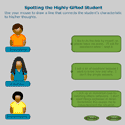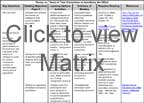Key Questions
- Why do special populations of very young gifted students, and the highly gifted, need special consider- ations for identi fica- tion, program ming, and curricular options?
You’ve already encountered some discussion of the special population of gifted known as the highly gifted. We will continue the discussion about this subpopulation in Week 7 because their parents or preschool teachers may identify them early. Viewing them from the perspective of the bell curve from Week 2, they are the students who would score three standard deviations or maybe more from the average student. They definitely qualify as a special population of gifted because of their uniqueness, even to the general gifted population. Highly gifted students are frequently placed at risk in the early years of school through misidentification, inappropriate grade placement, and a seriously inadequate curriculum.
Who the highly gifted really are varies. The terms for the levels of giftedness: moderately, highly, exceptionally, and profoundly gifted, are not standardized terms and may mean different things to different people. Here is a chart that is widely recognized to establish a framework to understand the differences.
| Levels of Giftedness | Full Scale IQ Score |
|---|---|
| Gifted or moderately gifted | 130-145 |
| Highly Gifted | 145-160 |
| Exceptionally Gifted | 160-180 |
| Profoundly Gifted | 180 and above |
The next question is much harder to answer: What does this level of giftedness mean?
A student's level of giftedness will mean something different to every student, in every family, school, and life situation. No one can say, these students are profoundly gifted so they cannot survive in traditional schools. There are no hard-and-fast rules or definitive research that supports a particular approach for each category of giftedness.
But there are some widely recognized generalizations in the gifted education field. Moderately gifted students tend to do well in the regular classroom, with the added challenge of differentiation, a gifted pullout enrichment program or mild acceleration in their areas of strength. Highly gifted students tend to do well in congregated gifted classes, such as offered in a few larger districts across the United States. These classes are most successful when they use a more in-depth curriculum, which also moves at a faster pace. Gifted students are different not only in their faster learning, but by their deeper interest and level of understanding. Both these differences must be addressed in a successful educational situation.
Exceptionally and profoundly gifted students often need more, and may do well in schools using a combination of congregated gifted classrooms with subject and grade acceleration. Congregated classrooms of only exceptionally gifted and profoundly gifted students would probably be more valuable to these students' education, but there are often not enough of them in any one school district to make the practice viable. Exceptionally and profoundly gifted students are commonly homeschooled for some part of their educational path. While not by any means a requirement, parents of these students often find themselves with no other option for a year, or a school level. And this can be the best alternative for some students.
Twice-exceptional students, those with both high levels of giftedness and learning disabilities, are great candidates for homeschooling. But these students, too, have other options. There are public school districts in the country that offer programs for moderately gifted students who also have learning disabilities. Other twice-exceptional students do best in school, but at a higher grade level, closer to their academic and social peers, with accommodations for their area of weakness.
What is right for the highly, exceptionally, or profoundly gifted student varies widely with each student. The best thing that parents, educators, and others working with that student can do is to actually work with the student. Make adjustments, offer opportunities, and try new placements, even if they are not commonly used for most students. The highly gifted, exceptionally gifted, and profoundly gifted students are not "most students." They are unique individuals, for whom modifications to the program must be made along the way.
 Click on the graphic on the left to launch an interactive activity to "peek into the minds" of some highly gifted students. Here are some recommendations from the Speyer School that will provide positive effects on the highly gifted students. As you view this information, think about how you can implement some of these recommendations into your classroom. In this activity, you will match students' thoughts to the appropriate characteristic or behavior. When finished, close the window to return to the course content.
Click on the graphic on the left to launch an interactive activity to "peek into the minds" of some highly gifted students. Here are some recommendations from the Speyer School that will provide positive effects on the highly gifted students. As you view this information, think about how you can implement some of these recommendations into your classroom. In this activity, you will match students' thoughts to the appropriate characteristic or behavior. When finished, close the window to return to the course content.
Most highly and profoundly gifted students present their uniqueness early in their development, long before attending school. Their cognitive development is rapid and needs to be nurtured. Too often, parents or caregivers attend to the physical needs, but do not know how to provide for their highly gifted toddlers. Read the following articles which address the early needs of our gifted and highly gifted children:
- Is it a Cheetah?
- Small Poppies: Highly Gifted Children in the Early Years
- NAGC Young Gifted Students
Summary
Highly, exceptionally, and profoundly gifted students have a right to be students, to learn and play, to be taught and teach themselves, to grow in physical, intellectual, social/emotional and spiritual ways to adulthood. Even if this means the student attends kindergarten at four, or high school three years early, or takes college courses at twelve. And they deserve to play in their own way, with their own friends, at their favorite games, no matter how different these are from what society sees as "appropriate" for other students of the same age. It is the job of educators to advocate for the needs of these students and to ensure that appropriate arrangements are made for them. It’s also public education’s responsibility to assist these students’ parents in finding appropriate resources outside the school setting. To do otherwise is to waste what may be one of our greatest natural resources.

